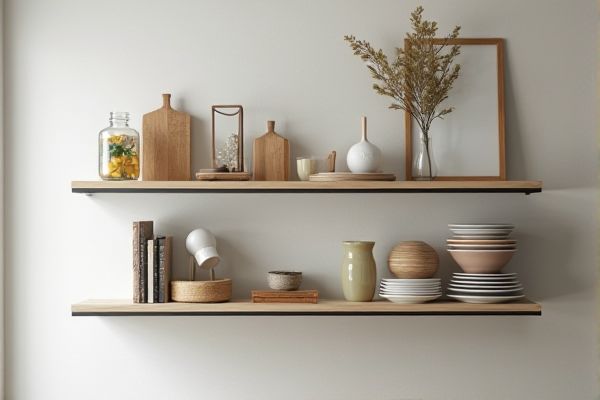
Retractable shelves provide flexible storage options by allowing you to extend and access items easily, while fixed shelves offer sturdy, permanent support ideal for heavier objects. Explore the rest of the article to discover which shelf type best suits your space and storage needs.
Table of Comparison
| Feature | Retractable Shelf | Fixed Shelf |
|---|---|---|
| Flexibility | Can be pulled out for easy access and pushed back | Static, remains in a fixed position |
| Space Optimization | Maximizes usable space by allowing access to stored items | Less efficient, can limit access to deep or back items |
| Installation | Requires hardware like runners or slides | Simple installation, fixed brackets or supports |
| Cost | Generally higher due to moving parts | Typically lower, fewer materials and components |
| Durability | Potential wear and tear on moving mechanisms | Higher durability with fewer moving parts |
| Usage | Ideal for tight spaces and frequent access | Best for stable storage where access frequency is low |
Introduction to Retractable and Fixed Shelves
Retractable shelves offer flexible storage solutions by sliding out smoothly to provide easy access and maximize space efficiency, ideal for compact areas or dynamic environments. Fixed shelves provide sturdy, permanent storage with consistent support, suitable for heavier items or organizational stability in both residential and commercial settings. Understanding the functionality and design distinctions of retractable versus fixed shelves helps in selecting the best option for specific storage needs and spatial constraints.
Key Differences Between Retractable and Fixed Shelves
Retractable shelves offer flexibility by sliding in and out, providing easy access to stored items and optimizing space in tight areas, while fixed shelves remain stationary, offering sturdy support ideal for heavier or frequently used objects. The key differences include mobility and space efficiency, where retractable shelves enhance accessibility and adjustability, whereas fixed shelves prioritize durability and structural stability. Your choice depends on whether you need adaptability for changing storage needs or consistent, reliable shelving.
Space Optimization: Retractable vs Fixed Shelving
Retractable shelves maximize space optimization by allowing users to extend or retract the shelf as needed, making it ideal for tight or irregular spaces. Fixed shelves provide consistent, stable storage but limit flexibility and can lead to underutilized areas in compact environments. Choosing retractable shelving enhances accessibility and efficient use of space, especially in small rooms or closets.
Installation Process and Ease of Use
Retractable shelves simplify the installation process with adjustable brackets and minimal tools, allowing quick customization and space-efficient setups. Fixed shelves require sturdy wall anchors and precise measurements for secure mounting, often demanding more time and expertise. Retractable designs enhance ease of use by enabling effortless access and flexible storage options compared to the static nature of fixed shelves.
Durability and Maintenance Comparison
A retractable shelf typically requires more maintenance due to its moving parts and mechanisms, which may wear out over time, whereas a fixed shelf offers greater durability with fewer chances of mechanical failure. Retractable shelves are often made from metal or reinforced plastic to withstand frequent use, but fixed shelves constructed from solid wood or metal provide long-lasting stability and strength with minimal upkeep. You should consider how often you'll use the shelf and whether ease of maintenance or robust durability is more important for your needs.
Cost Analysis: Which Shelf Offers Better Value?
Retractable shelves generally incur higher upfront costs due to complex mechanisms and installation requirements, while fixed shelves are more budget-friendly with minimal maintenance expenses. Over time, retractable shelves offer better value in spaces requiring frequent access and flexibility, as their convenience reduces labor costs and wear on items. Fixed shelves provide cost efficiency for static storage needs but lack the adaptability and ergonomic benefits of retractable models, impacting long-term operational savings.
Style and Aesthetic Considerations
Retractable shelves offer a sleek, modern look by concealing storage space when not in use, enhancing room minimalism and visual flow. Fixed shelves provide a classic, open display that emphasizes accessibility and decorative arrangement, perfect for showcasing books or collectibles. Your choice between the two impacts both the functional elegance and overall style of your interior design.
Suitable Applications for Each Shelf Type
Retractable shelves are ideal for environments requiring easy access and flexible storage, such as retail displays and kitchen cabinets, allowing users to extend the shelf for better visibility and convenience. Fixed shelves provide robust support and stability, making them suitable for heavy or permanent storage solutions found in libraries, warehouses, or closets. Choosing between retractable and fixed shelves depends on the need for mobility and accessibility versus stability and load capacity.
Pros and Cons of Retractable Shelves
Retractable shelves offer enhanced accessibility and space-saving benefits by sliding out to provide easier reach to stored items, making them ideal for deep cabinets and maximizing storage efficiency. However, these shelves may have weight limitations and require regular maintenance to ensure smooth operation, which can increase long-term costs compared to fixed shelves. Fixed shelves provide sturdy support and low maintenance but can limit accessibility, often requiring items to be moved to reach those at the back.
Pros and Cons of Fixed Shelves
Fixed shelves offer exceptional stability and durability, supporting heavy items without sagging or shifting, making them ideal for storing books, appliances, or large containers. They require minimal maintenance and are generally more cost-effective compared to retractable shelves, as they lack moving parts prone to wear and tear. However, fixed shelves can limit access to items stored at the back, potentially reducing convenience and requiring more effort to organize your space efficiently.
 homyna.com
homyna.com